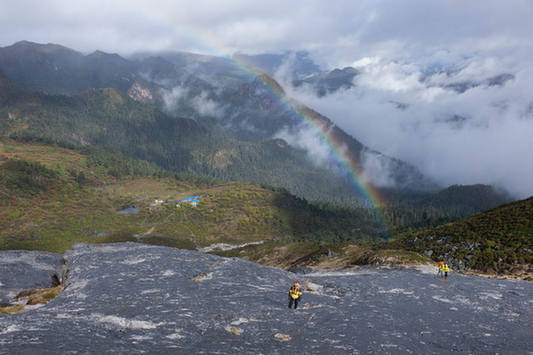The Ascent of Haba Snow Mountain
At 10 a.m. on October 5, 2013, I, along with 17 teammates and a group coordinator, reached the top of Haba. Standing next to the altitude mark, I texted “I made it!” to my family. The message was simple but we all knew it was hard earned.

The sight of a huge rainbow lifted our spirits.
Haba Village
Haba Snow Mountain is located in the southeast of Shangri-La County, 120 kilometers from the county center. In the language of the Naxi ethnic group, Haba means flowers of gold. The high altitude forms a typical alpine climate on the mountain that contains several climate zones, including a subtropical zone, a temperate zone, a cool temperature one and a frigid one. The range of temperatures from foot to summit typically covers 22.8 oC.
On October 1, my team of 19, including five women, gathered in Lijiang of Yunnan Province. My oldest teammate was 60. We arrived at Haba Village the next day. Situated at 2,600 meters above sea level, the small village is home to different ethnic groups: Tibetan, Yi, Naxi and Hui to name a few. The village is directly accessible by newly-built roads and costs in this area are relatively low, so Haba Snow Mountain is not only preferred by amateur climbers, but also chosen by professional teams as a training base.
Guesthouses and mountaineering clubs offering basic services can be found in the village. People seldom suffer from altitude sickness here, making the village an ideal place for pre-training.
Our team leader taught us how to knot ropes and use crampons and ice axes. On a hillside next to the village, we practiced emergency management skills for hours. It was the National Day holiday and all the guesthouses were full of climbers. As there were not enough rooms at our guesthouse, some of our team members decided to sleep in tents in the courtyard in preparation for the coming challenge.

